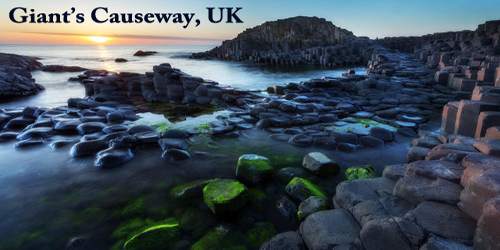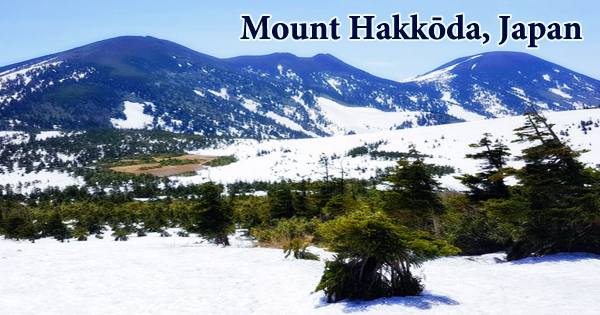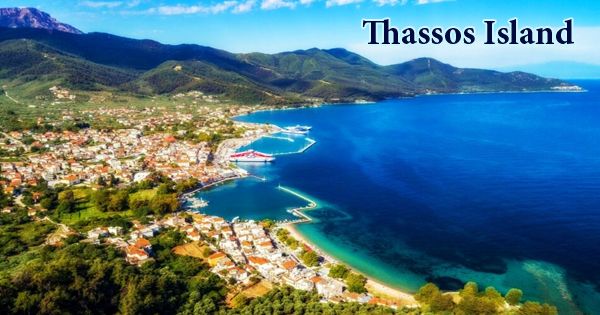The Giant’s Causeway and Causeway Coast is a spectacular area of global geological importance on the sea coast at the edge of the Antrim plateau in Northern Ireland. It is an area of about 40,000 interlocking basalt columns, the result of an ancient volcanic fissure eruption. It is located in County Antrim on the north coast of Northern Ireland, about three miles (4.8 km) northeast of the town of Bushmills.
It was declared a World Heritage Site by UNESCO in 1986 and a national nature reserve in 1987 by the Department of the Environment for Northern Ireland. In a 2005 poll of Radio Times readers, the Giant’s Causeway was named the fourth greatest natural wonder in the United Kingdom. The tops of the columns form stepping stones that lead from the cliff foot and disappear under the sea. Most of the columns are hexagonal, although there are also some with four, five, seven or eight sides. The tallest are about 12 meters (39 ft) high, and the solidified lava in the cliffs is 28 meters (92 ft) thick in places.
This dramatic sight has inspired legends of giants striding over the sea to Scotland. Celebrated in the arts and in science, it has been a visitor attraction for at least 300 years and has come to be regarded as a symbol for Northern Ireland. Much of the Giant’s Causeway and Causeway Coast World Heritage Site is owned and managed by the National Trust, and it is one of the most popular tourist attractions in Northern Ireland. Access to the Giant’s Causeway is free of charge: it is not necessary to go via the visitors centre, which charges a fee. The remainder of the site is owned by the Crown Estate and several private landowners.
The property’s accessible array of curious geological exposures and polygonal columnar formations formed around 60 million years ago make it a ‘classic locality’ for the study of basaltic volcanism. The features of the Giant’s Causeway and Causeway Coast site and in particular the strata exposed in the cliff faces, have been key to shaping the understanding of the sequences of activity in the Earth’s geological history.

Geology –
Around 50 to 60 million years ago, during the Paleocene Epoch, Antrim was subject to intense volcanic activity, when highly fluid molten basalt intruded through chalk beds to form an extensive lava plateau. As the lava cooled, contraction occurred. Horizontal contraction fractured in a similar way to drying mud, with the cracks propagating down as the mass cooled, leaving pillarlike structures, which also fractured horizontally into “biscuits”. In many cases, the horizontal fracture resulted in a bottom face that is convex, while the upper face of the lower segment is concave, producing what are called “ball and socket” joints. The size of the columns was primarily determined by the speed at which lava cooled. The extensive fracture network produced the distinctive columns seen today. The basalts were originally part of a great volcanic plateau called the Thulean Plateau, which formed during the Paleocene.
Criterion –
The cliff exposures of columnar and massive basalt at the edge of the Antrim Plateau present a spectacle of exceptional natural beauty. The extent of visible rock sections and the quality of the exposed columns in the cliff and on the Causeway combine to present an array of features of considerable significance.
The geological activity of the Tertiary era is clearly illustrated by the succession of the lava flows and interbasaltic beds which are in evidence on the Causeway Coast. Interpretation of the succession has allowed a detailed analysis of Tertiary events in the North Atlantic. The extremely regular columnar jointing of the Tholeiitic basalts is a spectacular feature which is displayed in exemplary fashion at the Giant’s Causeway. The Causeway itself is a unique formation and a superlative horizontal section through columnar basalt lavas.
Legend –
According to legend, the columns are the remains of a causeway built by a giant. The story goes that the Irish giant Fionn mac Cumhaill (Finn MacCool), from the Fenian Cycle of Gaelic mythology, was challenged to a fight by the Scottish giant Benandonner. Fionn accepted the challenge and built the causeway across the North Channel so that the two giants could meet.
In overall Irish mythology, Fionn mac Cumhaill is not a giant but a hero with supernatural abilities, contrary to what this particular legend may suggest. In Fairy and Folk Tales of the Irish Peasantry (1888), it is noted that, over time, “the pagan gods of Ireland grew smaller and smaller in the popular imagination, until they turned into the fairies; the pagan heroes grew bigger and bigger, until they turned into the giants”. There are no surviving pre-Christian stories about the Giant’s Causeway, but it may have originally been associated with the Fomorians (Fomhóraigh); the Irish name Clochán na bhFomhóraigh or Clochán na bhFomhórach means “stepping stones of the Fomhóraigh”. The Fomhóraigh are a race of supernatural beings in Irish mythology who were sometimes described as giants and who may have originally been part of a pre-Christian pantheon.
While the striking Causeway Coastal Route was already a site to behold, the region has seen a boom in tourism in recent years thanks to more fantasy. The TV series behemoth ‘Game of Thrones’ is filmed around these parts, so now many fans make the journey from far and wide to get perfect Instagram images in iconic locations from the show. The Dark Hedges area along the Bregagh Road is one of the most admired sites.
Integrity –
Most of the 70 ha site is in the ownership and management of the National Trust. Access to the coast is by a system of footpaths which allow visitors the opportunity to view the coastal scenery from the cliff tops and also examine the geological features at close range. The path is generally unobtrusive, and monitored and maintained to keep it in a safe condition. The cliff exposures and causeway stones, key attributes of the property, are protected by ownership in perpetuity by The National Trust. The removal of ‘souvenir’ stones from the Causeway, which occurred before the area was protected, has long since ceased.
Some of the structures in the area, having been subject to several million years of weathering, resemble objects, such as the Organ and Giant’s Boot structures. Other features include many reddish, weathered low columns known as Giant’s Eyes, created by the displacement of basalt boulders; the Shepherd’s Steps; the Honeycomb; the Giant’s Harp; the Chimney Stacks; the Giant’s Gate and the Camel’s Hump.
The area is a haven for seabirds, such as fulmar, petrel, cormorant, shag, redshank, guillemot and razorbill, while the weathered rock formations host numerous plant types, including sea spleenwort, hare’s-foot trefoil, vernal squill, sea fescue, and frog orchid. A stromatolite colony was reportedly found at the Giant’s Causeway in October 2011 an unusual find, as stromatolites are more commonly found in warmer waters with higher saline content than that found at the causeway.
Information Sources:
















